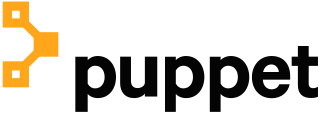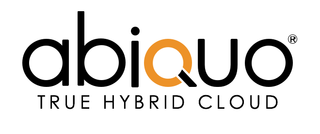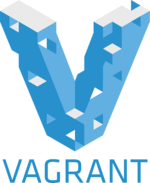Platform virtualization software, specifically emulators and hypervisors, are software packages that emulate the whole physical computer machine, often providing multiple virtual machines on one physical platform. The table below compares basic information about platform virtualization hypervisors.
A virtual appliance is a pre-configured virtual machine image, ready to run on a hypervisor; virtual appliances are a subset of the broader class of software appliances. Installation of a software appliance on a virtual machine and packaging that into an image creates a virtual appliance. Like software appliances, virtual appliances are intended to eliminate the installation, configuration and maintenance costs associated with running complex stacks of software.
Vyatta is a software-based virtual router, virtual firewall and VPN product for Internet Protocol networks. A free download of Vyatta has been available since March 2006. The system is a specialized Debian-based Linux distribution with networking applications such as Quagga, OpenVPN, and many others. A standardized management console, similar to Juniper JUNOS or Cisco IOS, in addition to a web-based GUI and traditional Linux system commands, provides configuration of the system and applications. In recent versions of Vyatta, web-based management interface is supplied only in the subscription edition. However, all functionality is available through KVM, serial console or SSH/telnet protocols. The software runs on standard x86-64 servers.
This is a comparison of notable free and open-source configuration management software, suitable for tasks like server configuration, orchestration and infrastructure as code typically performed by a system administrator.

Puppet is a software configuration management tool which includes its own declarative language to describe system configuration. It is being developed by Puppet Inc., founded by Luke Kanies in 2005. Its primary product, Puppet Enterprise, is a proprietary and closed-source version of its open-source Puppet software. They use Puppet's declarative language to manage stages of the IT infrastructure lifecycle, including the provisioning, patching, configuration, and management of operating system and application components in data centers and cloud infrastructures.

The TurnKey Linux Virtual Appliance Library is a free open-source software project which develops a range of Debian-based pre-packaged server software appliances. Turnkey appliances can be deployed as a virtual machine, in cloud computing services such as Amazon Web Services or installed in physical computers.
Eucalyptus is a paid and open-source computer software for building Amazon Web Services (AWS)-compatible private and hybrid cloud computing environments, originally developed by the company Eucalyptus Systems. Eucalyptus is an acronym for Elastic Utility Computing Architecture for Linking Your Programs To Useful Systems. Eucalyptus enables pooling compute, storage, and network resources that can be dynamically scaled up or down as application workloads change. Mårten Mickos was the CEO of Eucalyptus. In September 2014, Eucalyptus was acquired by Hewlett-Packard and then maintained by DXC Technology. After DXC stopped developing the product in late 2017, AppScale Systems forked the code and started supporting Eucalyptus customers.
Progress Chef is a configuration management tool written in Ruby and Erlang. It uses a pure-Ruby, domain-specific language (DSL) for writing system configuration "recipes". Chef is used to streamline the task of configuring and maintaining a company's servers, and can integrate with cloud-based platforms such as Amazon EC2, Google Cloud Platform, Oracle Cloud, OpenStack, IBM Cloud, Microsoft Azure, and Rackspace to automatically provision and configure new machines. Chef contains solutions for both small and large scale systems.

libvirt is an open-source API, daemon and management tool for managing platform virtualization. It can be used to manage KVM, Xen, VMware ESXi, QEMU and other virtualization technologies. These APIs are widely used in the orchestration layer of hypervisors in the development of a cloud-based solution.

OpenNebula is an open source cloud computing platform for managing heterogeneous data center, public cloud and edge computing infrastructure resources. OpenNebula manages on-premises and remote virtual infrastructure to build private, public, or hybrid implementations of Infrastructure as a Service and multi-tenant Kubernetes deployments. The two primary uses of the OpenNebula platform are data center virtualization and cloud deployments based on the KVM hypervisor, LXD/LXC system containers, and AWS Firecracker microVMs. The platform is also capable of offering the cloud infrastructure necessary to operate a cloud on top of existing VMware infrastructure. In early June 2020, OpenNebula announced the release of a new Enterprise Edition for corporate users, along with a Community Edition. OpenNebula CE is free and open-source software, released under the Apache License version 2. OpenNebula CE comes with free access to patch releases containing critical bug fixes but with no access to the regular EE maintenance releases. Upgrades to the latest minor/major version is only available for CE users with non-commercial deployments or with significant open source contributions to the OpenNebula Community. OpenNebula EE is distributed under a closed-source license and requires a commercial Subscription.

Cloud Foundry is an open source, multi-cloud application platform as a service (PaaS) governed by the Cloud Foundry Foundation, a 501(c)(6) organization.

Abiquo Hybrid Cloud Management Platform is a web-based cloud computing software platform developed by Abiquo. Written entirely in Java, it is used to build, integrate and manage public and private clouds in homogeneous environments. Users can deploy and manage servers, storage system and network and virtual devices. It also supports LDAP integration.
openQRM is a free and open-source cloud-computing management platform for managing heterogeneous data centre infrastructures.
AWS Elastic Beanstalk is an orchestration service offered by Amazon Web Services for deploying applications which orchestrates various AWS services, including EC2, S3, Simple Notification Service (SNS), CloudWatch, autoscaling, and Elastic Load Balancers. Elastic Beanstalk provides an additional layer of abstraction over the bare server and OS; users instead see a pre-built combination of OS and platform, such as "64bit Amazon Linux 2014.03 v1.1.0 running Ruby 2.0 (Puma)" or "64bit Debian jessie v2.0.7 running Python 3.4 ". Deployment requires a number of components to be defined: an 'application' as a logical container for the project, a 'version' which is a deployable build of the application executable, a 'configuration template' that contains configuration information for both the Beanstalk environment and for the product. Finally an 'environment' combines a 'version' with a 'configuration' and deploys them. Executables themselves are uploaded as archive files to S3 beforehand and the 'version' is just a pointer to this.

VNS3 is a software-only virtual appliance that allows users to control access and network topology and secure data in motion across public and private clouds. VNS3 is a virtual router, switch, firewall, protocol re-distributor, and SSL/IPSec VPN concentrator. The Network Virtualization Software creates a customer-controlled overlay network over top of the underlying network backbone.

Proxmox Virtual Environment is a virtualisation platform designed for the provisioning of hyper-converged infrastructure.

BOSH is an open-source software project that offers a toolchain for release engineering, software deployment and application lifecycle management of large-scale distributed services. The toolchain is made up of a server and a command line tool. BOSH is typically used to package, deploy and manage cloud software. While BOSH was initially developed by VMware in 2010 to deploy Cloud Foundry PaaS, it can be used to deploy other software. BOSH is designed to manage the whole lifecycle of large distributed systems.
HashiCorp, Inc. is an American software company with a freemium business model based in San Francisco, California. HashiCorp provides tools and products that enable developers, operators and security professionals to provision, secure, run and connect cloud-computing infrastructure. It was founded in 2012 by Mitchell Hashimoto and Armon Dadgar. The company name HashiCorp is a portmanteau of co-founder last name Hashimoto and Corp.
Terraform is an infrastructure-as-code software tool created by HashiCorp. Users define and provide data center infrastructure using a declarative configuration language known as HashiCorp Configuration Language (HCL), or optionally JSON.
Buddy is a web-based and self-hosted continuous integration and delivery software for Git developers that can be used to build, test, and deploy web sites and applications with code from GitHub, Bitbucket, and GitLab. It employs Docker containers with pre-installed languages and frameworks for builds, alongside DevOps, monitoring and notification actions.










